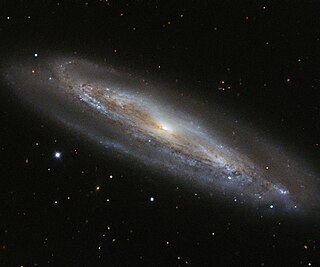
Messier 98, M98 or NGC 4192, is an intermediate spiral galaxy about 44.4 million light-years away in slightly northerly Coma Berenices, about 6° to the east of the bright star Denebola. It was discovered by French astronomer Pierre Méchain on 1781, along with nearby M99 and M100, and was catalogued by compatriot Charles Messier 29 days later in his Catalogue des Nébuleuses & des amas d'Étoiles. It has a blueshift, denoting ignoring of its fast other movement, it is approaching at about 140 km/s.

Messier 99 or M99, also known as NGC 4254, is a grand design spiral galaxy in the northern constellation Coma Berenices approximately 15,000,000 parsecs from the Milky Way. It was discovered by Pierre Méchain on 17 March 1781. The discovery was then reported to Charles Messier, who included the object in the Messier Catalogue of comet-like objects. It was one of the first galaxies in which a spiral pattern was seen. This pattern was first identified by Lord Rosse in the spring of 1846.

NGC 4323 is a lenticular or dwarf elliptical galaxy located about 52.5 million light-years away in the constellation Coma Berenices. The galaxy was discovered in 1882 by astronomer Wilhelm Tempel and is a member of the Virgo Cluster.

NGC 4666 is a spiral galaxy in the equatorial constellation of Virgo, located at a distance of approximately 55 megalight-years from the Milky Way. It was discovered by the German-born astronomer William Herschel on February 22, 1784. It is a member of the Virgo II Groups, a series of galaxies and galaxy clusters strung out from the southern edge of the Virgo Supercluster. John L. E. Dreyer described it as "bright, very large, much extended 45°±, pretty suddenly brighter middle". It is a member of an interacting system with NGC 4668 and a dwarf galaxy, and belongs to a small group that also includes NGC 4632.

NGC 5775 is a spiral galaxy, a member of the Virgo Cluster, that lies at a distance of about 70 million light-years. Although the spiral is tilted away from us, with only a thin sliver in view, such a perspective can be advantageous for astronomers. For instance, astronomers have previously used the high inclination of this spiral to study the properties of the halo of hot gas that is visible when the galaxy is observed at X-ray wavelengths. It is a member of the NGC 5775 Group of galaxies, itself one of the Virgo III Groups strung out to the east of the Virgo Supercluster of galaxies.

NGC 3185 is a spiral galaxy located 20.4 Mpc away in the Leo constellation. NGC 3185 is a member of a four-galaxy group called HCG 44. It is also a member of the NGC 3190 Group of galaxies, which is a member of the Leo II Groups, a series of galaxies and galaxy clusters strung out from the right edge of the Virgo Supercluster.
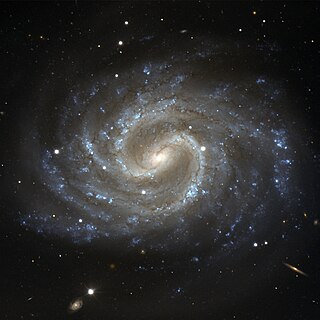
NGC 4535 is a barred spiral galaxy located some 54 million light years from Earth in the constellation Virgo. It is a member of the Virgo Cluster of galaxies and is located 4.3° from Messier 87. The galactic plane of NGC 4535 is inclined by an angle of 43° to the line of sight from the Earth. The morphological classification of NGC 4535 in the De Vaucouleurs system is SAB(s)c, which indicates a bar structure across the core (SAB), no ring (s), and loosely wound spiral arms (c). The inner part of the galaxy has two spiral arms, which branch into multiple arms further away. The small nucleus is of type HII, meaning the spectrum resembles that of an H II region.

NGC 3501 is a spiral galaxy 80 million light years away. It is located in the constellation Leo. The galaxy was imaged by the Hubble Space Telescope in 2014, showing an edge-on spiral galaxy; its companion NGC 3507 is not included in the photograph. It is a member of the NGC 3607 Group of galaxies, which is a member of the Leo II Groups, a series of galaxies and galaxy clusters strung out from the right edge of the Virgo Supercluster.

NGC 78 is a pair of galaxies in the constellation Pisces. NGC 78A, which is the more southern galaxy, is a barred spiral galaxy. NGC 78B, which is the more northern galaxy, is an elliptical galaxy. Although the designations NGC 78A and 78B are used today, the designation NGC 78 was formerly used mainly for the northern galaxy.

NGC 3718, also called Arp 214, is a galaxy located approximately 52 million light years from Earth in the constellation Ursa Major. It is either a lenticular or spiral galaxy.
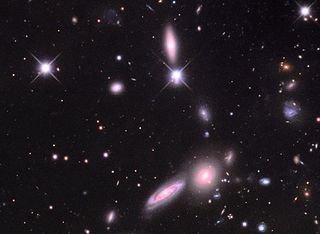
NGC 85 is an interacting spiral or lenticular galaxy estimated to be about 200 million light-years away in the constellation of Andromeda. It was discovered by Ralph Copeland in 1873 and its apparent magnitude is 15.7. The galaxy appears to be interacting with the companion spiral IC 1546.

NGC 90 is an interacting spiral galaxy estimated to be about 300 million light-years away in the constellation of Andromeda. It was discovered by R. J. Mitchell in 1854 and its apparent magnitude is 13.7. The galaxy is currently interacting with NGC 93 and exhibits two highly elongated and distorted spiral arms with bright blue star clusters indicative of star formation, likely caused by the interaction with its neighbor.

NGC 93 is an interacting spiral galaxy estimated to be about 260 million light-years away in the constellation of Andromeda. It was discovered by R. J. Mitchell in 1854. The galaxy is currently interacting with NGC 90 and has some signs of interacting with it.
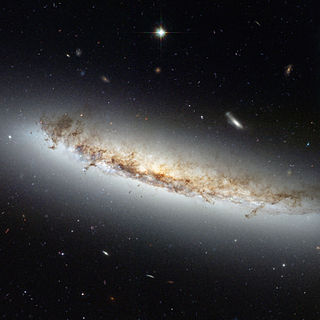
NGC 4402 is a relatively near, edge-on spiral galaxy located around 50 million light-years from Earth. It is in the constellation of Virgo within the Virgo Cluster of galaxies. It can be seen when viewing Markarian's Chain.
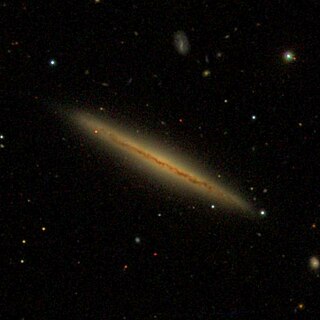
NGC 5470 is an edge-on spiral galaxy located between 43 and 68 million light-years away in the constellation Virgo. It was discovered by astronomer John Herschel in 1830. It is a member of the Virgo III Groups, a series of galaxies and galaxy clusters strung out to the east of the Virgo Supercluster of galaxies.
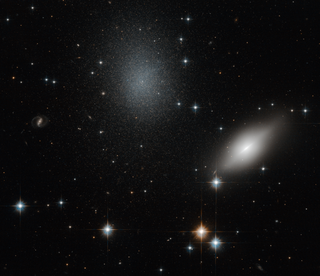
NGC 5011 is an elliptical galaxy in the constellation of Centaurus. It was discovered on 3 June 1834 by John Herschel. It was described as "pretty bright, considerably small, round, among 4 stars" by John Louis Emil Dreyer, the compiler of the New General Catalogue.

NGC 4633 is a spiral galaxy located about 70 million light-years away in the constellation of Coma Berenices. It is interacting with the nearby galaxy NGC 4634. NGC 4633 was discovered by astronomer Edward D. Swift on April 27, 1887. It was rediscovered on November 23, 1900, by astronomer Arnold Schwassmann and was later listed as IC 3688. NGC 4633 is a member of the Virgo Cluster.

NGC 5030 is a barred spiral galaxy in the constellation Virgo. The object was discovered on 17 March 1881 by the American astronomer Edward Singleton Holden.
NGC 4918 is a spiral galaxy in the constellation Virgo. The object was discovered in 1886 by the American astronomer Francis Preserved Leavenworth.

NGC 4380 is an unbarred spiral galaxy located in the constellation of Virgo. Located about 52.2 million light-years away, is a member of the Virgo Cluster, a large galaxy cluster. It was discovered on March 10, 1826 by the astronomer John Herschel.




















